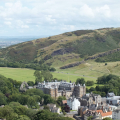Built on an ancient extinct volcano, Edinburgh Castle is the heart of the Scottish capital. It was built in the 12th century by David I. It quickly served as a political and military stronghold when the King of England, Edward I, tried to seize the vacant throne of Scotland. Between 1296 and 1341, it sometimes moved from one camp to the other and suffered considerable damage. It was largely rebuilt by David II but was re-sieged in 1571 to crush the entrenched followers of Mary Queen of Scots. The hostilities are known as "Lang Siege" (the long siege) and last for two years. In 1650, the castle is again seized by the English when Cromwell's troops invade the country. After the restoration of 1660, it remains under the authority of London which keeps troops there permanently. The Jacobites tried to seize it from their first uprising in 1688, in vain. Their second revolution led by Bonnie Prince Charlie was no more effective, despite their capture of the city in 1745. They were driven out in November of the same year and the colossus remained an English fortress from then on. At the entrance to the castle, two statues recall Scotland's tumultuous past: William Wallace and Robert the Bruce, the heroes of independence. Once past the Portcullis Gate, after the ticket office, a sign on the right indicates when the next guided tour will take place. A guide is often already there and will point out this to newcomers. Follow it, it's a good introduction, it's free and quite short. To your right, the guns of Argyle Battery offer superb views of the city. A few steps away, the One O'clock Gun is a 105 mm L118. It entered service in 2001 and continues a tradition that began in 1861. Every day except Sundays, at 1pm, when the sphere of the Nelson Monument is lowered on Calton Hill, a cannon is fired at the castle to announce the time to the sailors of Leith.
The National War Museum is a little further on. It covers 400 years of martial history in a very vivid way thanks to numerous objects, weapons, uniforms, testimonies, images and films. On land, sea and in the air, the Scots have forged an identity as fighters all over the world. The two World Wars are of course widely covered, but also more recent conflicts.
The Royal Scots Dragoon Guards Museum and the Royal Scots Museum are located higher up, continuing the ascent of Castle Rock. To reach them, you will pass the Governor's House and the barracks of the Royal Regiment of Scotland, two army buildings still in use. Inside both museums, the history of these iconic regiments is told from their creation to the present day.
Continuing towards Crown Square, you will pass successively through several major monuments. Military prisons were used extensively during the Napoleonic Wars and the American War of Independence. The tiny 12th century St Margaret's Chapel is the oldest building in the castle and certainly in Edinburgh. Behind it is Mons Meg, a huge 15th century cannon built in Flanders. If you lean over the ramparts at the same level, you will see a small dog cemetery which is not accessible. This is where the soldiers buried their canine friends from 1840 onwards. Further on, Half-Moon Battery is a vast half-moon esplanade, erected with cannons. Built from 1573, it took the place of David's Tower (1368), which was destroyed during the "Lang Siege".
Crown Square is the heart of the castle and its highest point. The Scottish National Memorial is a superb building paying vibrant tribute to Scotland's fallen soldiers. Across the street from it is the Great Hall with its huge dimensions and magnificent interior, measuring 29m by 12.5m. The star of this great square is the Royal Palace. Built in the 15th century and refurbished in the 17th century, it houses the room where Mary Queen of Scots gave birth to James VI. You can also see the Scottish Crown Jewels and the Stone of Scone.
The Stone ofScone is a 152 kg stone that was used for the coronation of Scottish kings before being stolen by the English in 1296. It is then placed under the King Edward's Chair, on which each new English sovereign sits. In December 1950, students from Glasgow decided to steal it from Westminster Abbey and bring it back to Scotland. When they removed it from the throne, they knocked it down and broke it in half. Fearing they would run out of time, they hid the larger piece in a field in Kent and the smaller one in one of their cars, which they left at a friend's house in the Midlands. When authorities discover the theft, they close the Anglo-Scottish border for the first time in 400 years. A little later, the young nationalists returned to Glasgow to collect their loot and have the stone reassembled with a word that no one knows the contents to this day. In April 1951, the police found the Stone of Scone at Arbroath Abbey (Angus) and caught the thieves confessing their actions. They were not prosecuted for fear of political repercussions and the relic was returned to Westminster. In November 1996, the British government decided to return it to its country of origin to satisfy the growing demand, on condition that it be present in London for each coronation.
Did you know? This review was written by our professional authors.
Members' reviews on EDINBURGH CASTLE
The ratings and reviews below reflect the subjective opinions of members and not the opinion of The Little Witty.
Très bien entrenu, avec une vue imprenable sur toute la ville.
Forteresse sur les hauteurs de la ville avec beaucoup de salles et de musées à visiter. Prévoir 3 heures pour la visite. Entrée un peu chère : prendre un pass pour la rentabiliser si vous visitez d'autres sites en Ecosse













Cependant, je trouve le prix d'entrée assez chère, 23€ environ.